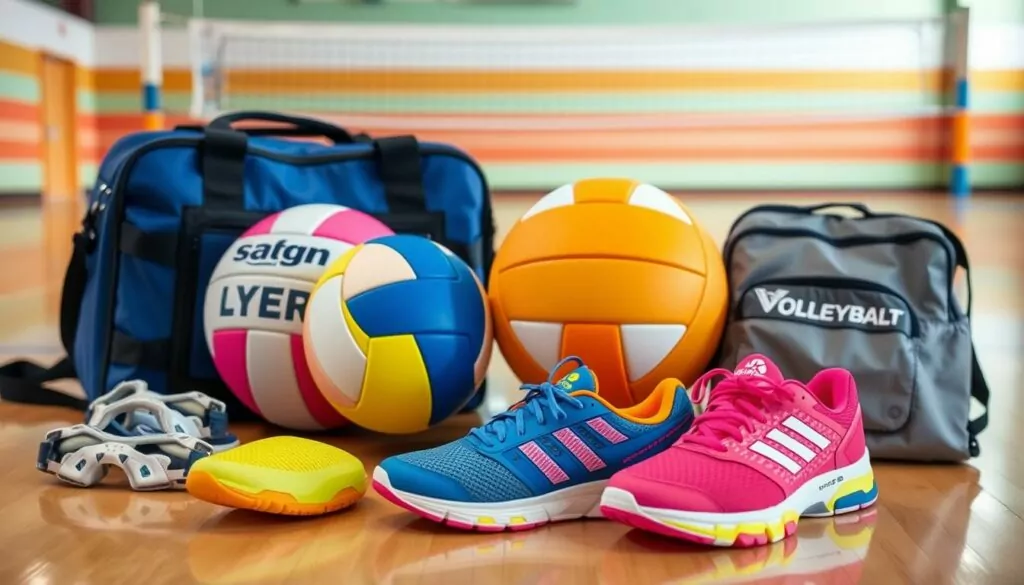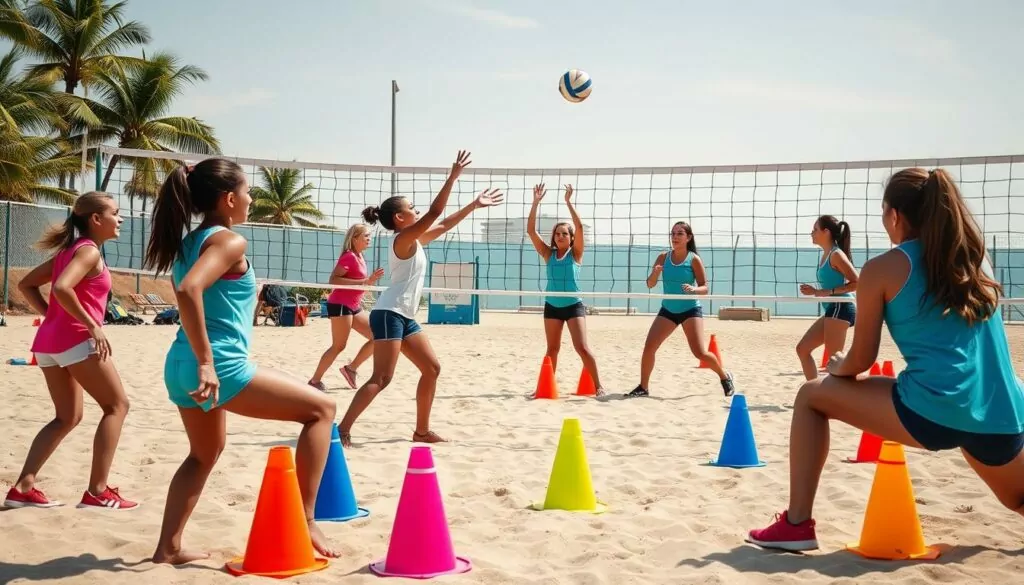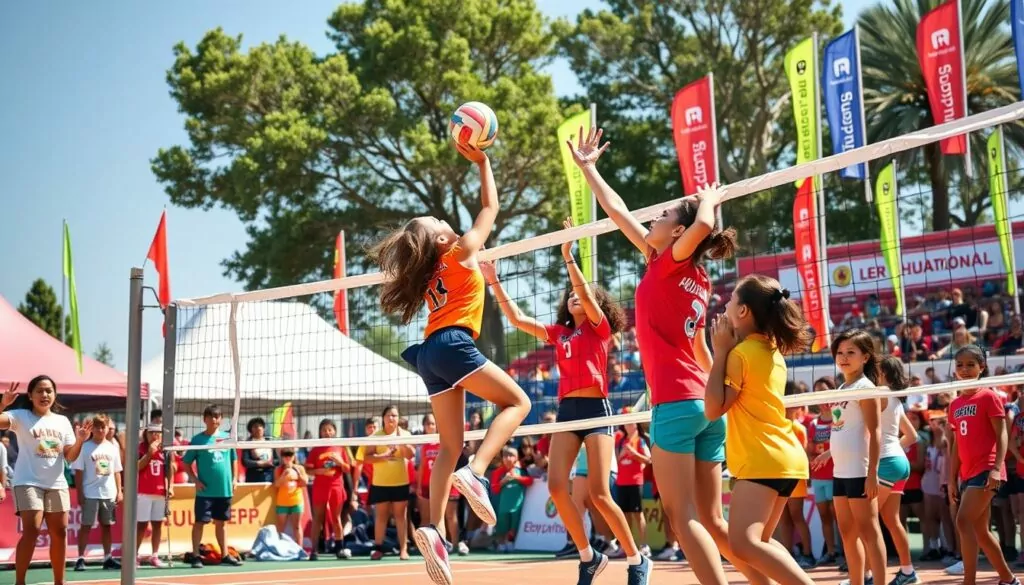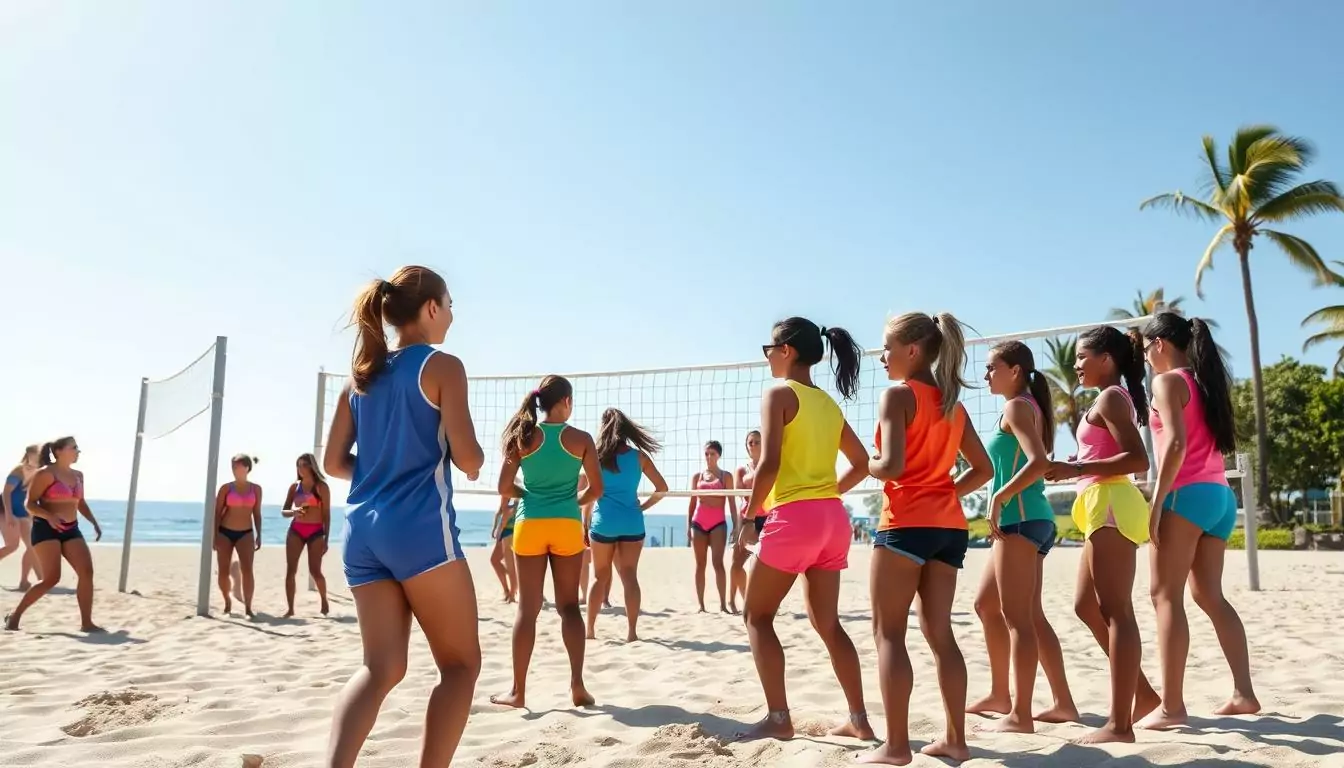Volleyball has become the top high school girls’ sport since 2015. With 1,802 college programs, it offers great chances for growth and teamwork. Your support is vital in your child’s athletic journey.
This parent’s guide to girls’ youth volleyball will help you explore youth sports and volleyball coaching.
Girls’ athletics are booming, with volleyball at the forefront. Youth programs and parenting advice for volleyball families are growing. This guide covers basics and support for your young athlete.
Club volleyball is a popular choice for many players. Costs can range from $350 to over $5,000 per season. The season typically runs from November to July for teams attending major events.
When choosing a club, think about practice frequency, coaching experience, and team levels. These factors will help you make the best decision for your daughter.
Key Takeaways
- Volleyball is now the most popular high school girls’ sport in the U.S.
- There are 1,802 women’s volleyball college programs, offering numerous opportunities
- Club volleyball costs can range from $350 to over $5,000 per season
- The girls’ club volleyball season typically runs from November to July
- Parents play a crucial role in supporting their child’s athletic journey and fostering good sportsmanship
- Selecting a club involves considering factors like practice frequency, coaching experience, and team playing levels
Understanding the Basics of Girls’ Youth Volleyball
Girls’ youth volleyball is a fun way for young athletes to stay active. It helps develop teamwork skills. Learning volleyball terms and rules can help parents support their child’s sports journey.
The Volleyball Court Layout
Youth volleyball courts are smaller than adult ones. Teams can have two to four players per side. This setup helps young players cover the court and enjoy longer rallies.
Key Rules of Play
Youth volleyball rules encourage skill growth and fair play. Players rotate clockwise for service, giving everyone equal playing time. Ball handling faults include hitting the ball more than four times.
Lifting or throwing the ball is not allowed. Players can’t touch the net. Servers get two chances at tossing. Various serving styles are allowed, including underhand and overhand.
Scoring System and Match Structure
Games in youth volleyball usually go to 25 points. A two-point lead is needed to win. Matches can be one game or best two out of three.
If needed, a third set is often played to 15 points. This structure allows for shorter matches, fitting younger players’ energy levels.
| Aspect | Youth Volleyball | Adult Volleyball |
|---|---|---|
| Ball Size | Lighter version for under 12 | Standard size |
| Team Size | 2-4 players | 6 players |
| Court Size | Smaller | 30′ x 60′ indoor |
| Match Length | 1-3 sets | 3-5 sets |
These basics will help you become a more informed volleyball parent. You’ll be better equipped to support your child’s volleyball journey. Youth volleyball focuses on fun, skill growth, and teamwork over competition.
Essential Equipment and Gear for Young Players

The right gear is key for young volleyball players’ success and safety. Understanding basic equipment helps parents make smart choices. Let’s explore what every young player needs.
The volleyball is the most crucial piece of equipment. Beginners use a lightweight “First Touch” ball weighing 0.5 ounces. As players improve, they move to a “Volley Lite” ball for 1st to 6th graders.
Older players may prefer the heavier “U12 Molton” volleyball. Volleyball shoes provide necessary support and traction for quick court movements. Knee pads protect against floor burns and impacts.
Most youth programs require matching tops. Rules on shorts can vary between leagues.
| Age Group | Recommended Ball | Weight (ounces) | Usage |
|---|---|---|---|
| 1st grade and below | First Touch | 0.5 | Beginner practice |
| 1st-6th grade (12U) | Volley Lite | 7.0-7.7 | Indoor practice and games |
| 12U and above | U12 Molton | 8.1 | Advanced practice and games |
Pack extra socks, a small blanket, and hand sanitizer for comfort and hygiene. Coaches may appreciate a volleyball journal and a tripod for recording games.
Remove jewelry before play, except for medical alert and religious items. These essentials set your young athlete up for a great volleyball experience.
Parent’s Guide to Girls’ Youth Volleyball: Roles and Responsibilities
Your role in girls’ youth volleyball goes beyond sideline cheering. Your support shapes your child’s athletic journey and experience. Let’s explore key responsibilities for effective volleyball parent support.
Supporting Your Child’s Athletic Journey
Foster a positive environment for your young athlete. Encourage skill development and good sportsmanship, not just winning. Positive reinforcement builds confidence and helps children achieve goals.
Allow your child to set their own objectives. Avoid imposing your standards on them. This approach promotes independence and self-motivation.
Communicating with Coaches and Officials
Effective communication is crucial for a successful volleyball experience. Avoid sideline coaching or refereeing. Support coaches and officials in their roles.
Address concerns privately and respectfully. This approach models good volleyball parent etiquette for your child.
Fostering a Positive Sports Environment
Create a positive atmosphere for your child’s volleyball growth. Applaud good plays by both teams. Work to eliminate verbal and physical abuse from youth sports.
Your behavior sets the tone for your child’s attitude. Model good sportsmanship and respect for all involved in the game.
“The most important thing is to try and inspire people so that they can be great in whatever they want to do.” – Kobe Bryant
Embracing these principles contributes to a rewarding experience for your child and team. Your positive involvement makes a significant difference in your young athlete’s volleyball journey.
For more insights on choosing the right volleyball club, check out this comprehensive parents’ guide.
Skill Development and Training for Young Volleyball Players

Girls volleyball development blends physical skills, mental prep, and sportsmanship. Youth volleyball training builds a strong foundation for future success. It’s a journey that shapes players both on and off the court.
Fundamental Volleyball Techniques
Mastering basic skills is key for volleyball game preparation. Key drills improve technique and help players grow. These exercises boost control, accuracy, and muscle memory.
- Passing to yourself
- Pass to yourself and catch
- Approach and hand movement
- Pass and hit sequence
- Serve and pass to target
Coaches should make practices fun and engaging. This approach helps players learn and improve faster. It also keeps them motivated to continue playing.
Physical Conditioning for Youth Athletes
Volleyball requires agility, strength, and endurance. Young players can benefit from specific exercises. These workouts target key areas for volleyball success.
- Jump rope for footwork
- Bodyweight squats for leg strength
- Planks for core stability
- Sprint intervals for speed
Mental Preparation and Sportsmanship
Mental toughness is crucial in volleyball. Players should learn to set goals and visualize success. Developing a pre-game routine can boost confidence and focus.
- Set realistic goals
- Practice visualization
- Develop a pre-game routine
- Show respect for teammates, opponents, and officials
Success in volleyball goes beyond winning matches. It’s about building character and growing as a person. Respect and fair play are key parts of the sport.
| Aspect | Focus Areas |
|---|---|
| Technical Skills | Passing, Setting, Hitting, Serving |
| Physical Conditioning | Agility, Strength, Endurance |
| Mental Preparation | Goal Setting, Visualization, Focus |
| Sportsmanship | Respect, Teamwork, Fair Play |
Navigating Competitions and Tournaments

Youth volleyball tournaments showcase young athletes’ skills. Parents should understand these events to support their child’s journey. Let’s explore youth volleyball competitions and how to maximize these experiences.
Volleyball tournaments come in various formats. Pool play involves round-robin matches within groups. Results determine seeding for elimination rounds in bracket play.
When choosing a volleyball club, consider coaching philosophy and practice schedules. Look for clubs that match your child’s goals and commitment level.
- Open Division: Highest level of competition
- National Division: Strong regional teams
- USA Division: Developing competitive teams
- American Division: Local level competition
Coaches play a crucial role in tournament success. They help players manage emotions during high-stakes matches. Coaches also guide warm-up routines and provide strategies for tiebreakers.
Club selection affects tournament experiences. Some focus on local events, while others join national qualifiers. High-level tournaments offer bids to prestigious championships, adding excitement to the season.
“Tournaments are not just about winning. They’re opportunities for growth, teamwork, and creating lasting memories.”
Each tournament helps your child learn and improve. With proper support, these competitions become valuable steps in their athletic growth.
Conclusion: Embracing the Journey of Youth Volleyball
Youth volleyball parenting is more than just sideline cheering. It’s about creating a positive space for young athletes to grow. Your role shapes your child’s experience in the sport.
Focus on effort and improvement instead of just wins. This approach builds resilience and love for volleyball. It also helps develop character and sportsmanship.
Balanced support is key in youth volleyball. Encourage your child to take risks and learn from mistakes. This enhances their skills and builds confidence on the court.
Youth sports offer health benefits too. They reduce obesity risk and improve heart health. Your support in volleyball contributes to your child’s overall well-being.
Team dynamics in volleyball teach important life lessons. Kids learn teamwork, conflict resolution, and appreciating differences. These skills often carry into adulthood.
Time management and goal-setting are also valuable takeaways from volleyball. By supporting your child’s journey, you’re helping them grow as athletes and individuals.
FAQ
What are the basic rules of girls’ youth volleyball?
Volleyball rules include three touches per side and rally scoring. Players rotate positions after winning the serve. Common errors are double contact, lift/carry, and net violations.
What equipment is needed for youth volleyball players?
Players need proper shoes, knee pads, and a regulation volleyball. Under-12 players use a “light” version of the adult ball. Uniforms should match and be numbered 1-99.
Jewelry must be removed, except for medical alert and religious reasons. Youth programs may not always require matching tops or shorts.
How can parents support their child’s athletic journey?
Parents should encourage skill improvement and good sportsmanship, not just winning. Positive reinforcement helps children achieve their goals. Let children set their own goals without imposing parental standards.
What is the role of parents during games and practices?
Parents should avoid sideline coaching or refereeing. Instead, support coaches and officials. Create a positive environment by applauding good plays from both teams.
Work to remove verbal and physical abuse from youth sports activities.
What are the fundamental volleyball techniques young players should develop?
Key techniques include serving, passing, setting, hitting, and blocking. Physical conditioning should focus on age-appropriate agility, strength, and endurance. Mental preparation involves developing focus, resilience, and teamwork skills.
How should parents approach competitions and tournaments?
Tournaments let players test skills and experience different play levels. Parents should understand pool play and bracket systems. Help children manage expectations and emotions during competitions.
What factors should be considered when selecting a volleyball club?
When choosing a club, look at coaching philosophy, practice schedules, and competition levels. Understand the commitment required for travel teams and associated costs.
